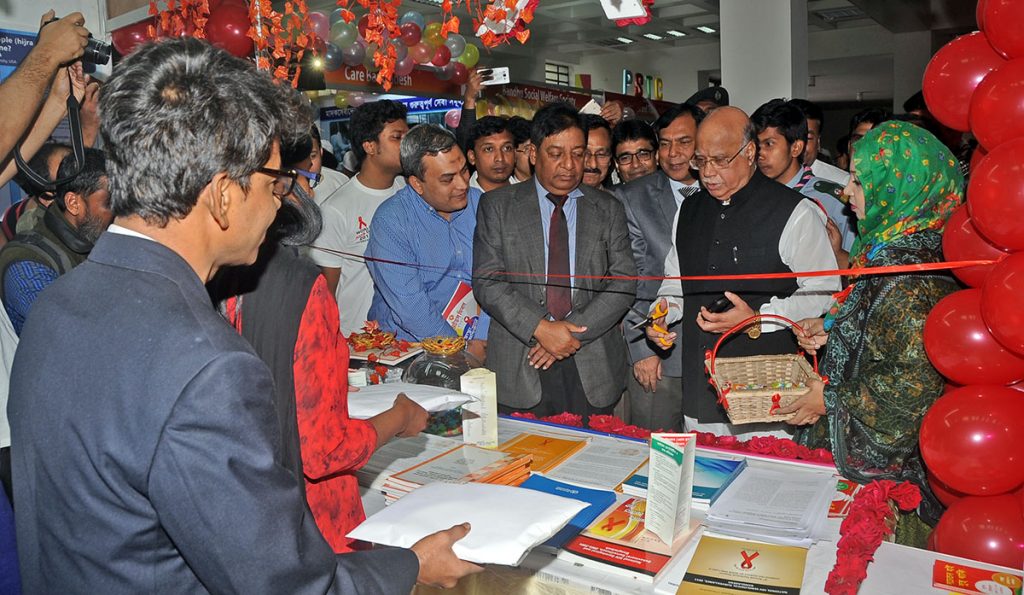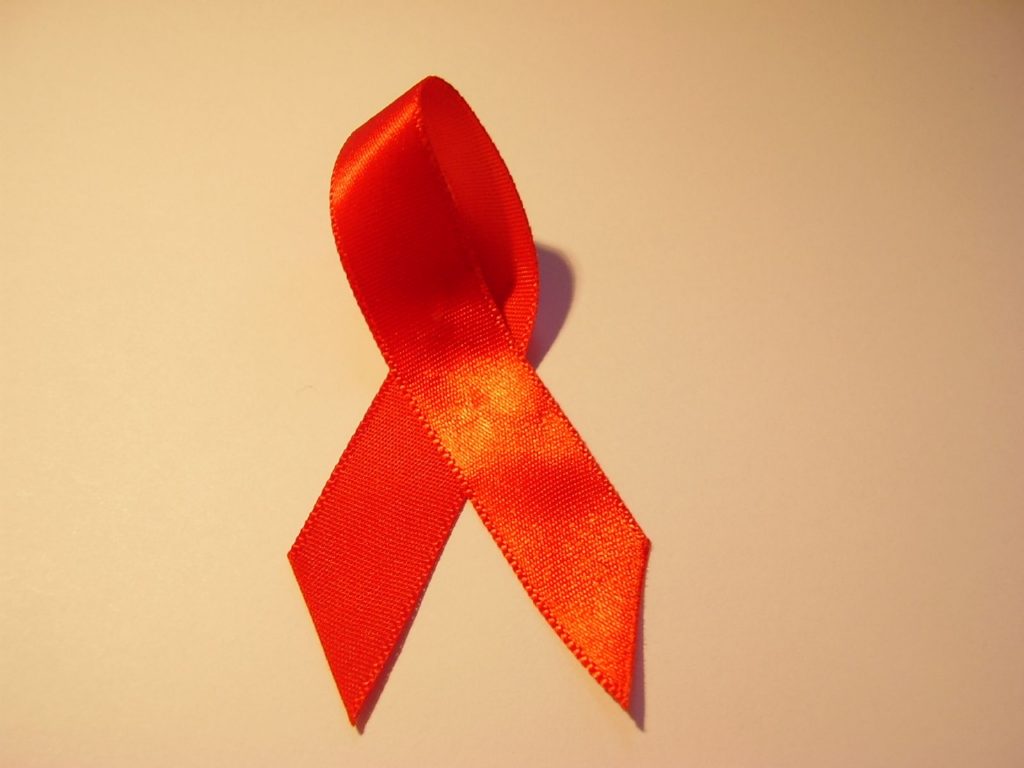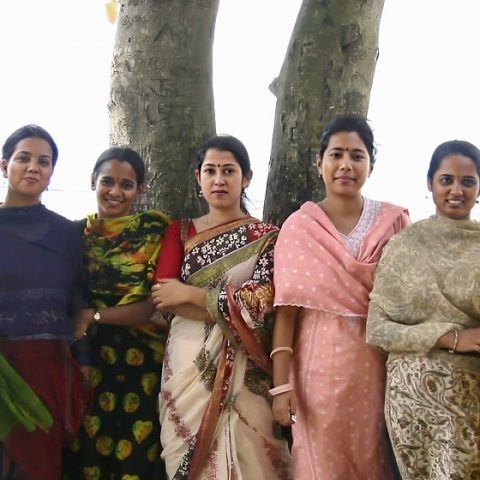The Programme for HIV and AIDS under the Infectious Diseases Division at icddr,b provides good quality HIV prevention services to vulnerable populations at risk of HIV infection, this has been made possible by working with the Government of Bangladesh (GoB), donors, NGOs and CBOs.

Mr Mohammed Nasim, MP, Honourable Minister of Health and Family Welfare, inaugurated icddr,b stall on the occasion of World AIDS Day 2017 celebration in Dhaka.
Bangladesh is a country with a concentrated HIV epidemic, having a prevalence rate of 3.9 per cent among all key populations (KPs) at risk of HIV, with the highest HIV prevalence among people who inject drugs (PWID). The GoB took a proactive leading approach to prevent the spread of HIV in Bangladesh through the early establishment of a National AIDS Committee in 1985 – four years before the first HIV infection was detected in the country.
Implementation of the HIV prevention programmes were targeted toward KPs based on strategic information revealed from HIV surveillance and other studies. A state-of-the-art surveillance system, in place since 1998, and 12 serological and 10 behavioural surveillance surveys have provided critical guidance to better target the KPs to ensure more effective HIV interventions. The role of the Programme for HIV and AIDS at icddr,b in the national Serological and Behavioural Surveillances is a critical component of its success. Under the leadership of AIDS/STD Programme (ASP), and in partnership with the Institute of Epidemiology and Disease Control Research (IEDCR), icddr,b conducted surveillances from 1998 – 2016.
Contained HIV and sexually transmitted infections (STIs) among sexual minority: success of icddr,b guided HIV prevention programmes implemented by civil society organisations (CSOs)

AIDS awareness ribbon. Photo: Anqa / CC BY-NC 2.0
Since 2010, utilising the Global Fund to Fight AIDS, Tuberculosis and Malaria (GFATM) grant, icddr,b and its CSOs partners have established 66 health service centres to provide HIV prevention services to 31,000 people from sexual minority communities such as males having sex with males (MSM), male sex workers (MSW), and 4,062 transgender women (locally known as hijra) in 40 districts in Bangladesh.
The HIV prevention services of icddr,b are evaluated by impact and outcome indicators, such as prevalence of HIV and safer sex practices (e.g. condom use in sexual intercourse with the male sex partners). As part of the national HIV surveillance, the last HIV serological and behavioural survey among MSM, MSW and the hijra was conducted in Dhaka in 2015, with data showing that the prevalence of HIV among these groups was within 1 per cent.
In addition, the prevalence of active syphilis, a surrogate marker of HIV, also declined over the time, another successful indicator of the programme. The prevalence of active syphilis has significantly declined among the hijra from 10.4 per cent in 2002 to 2.1 per cent in 2015; among MSW from 7.7 per cent in 2000 to 1.2 per cent in 2015. The prevalence of active syphilis among MSM was around 2 per cent from 2000 – 2015.
Data from the 2015 behavioural survey showed that condom use among MSM, MSW and the hijra in the ‘most recent anal sex act with a male sex partner’ has also improved significantly. Condom use among MSM significantly increased from 25.6 to 54 per cent; among MSW from 34.6 to 53.5 per cent and among the hijra from 17.5 to 41.1 per cent from 2010 to 2015. These achievements highlight the success of icddr,b’s Programme for HIV and AIDS in providing a valuable contribution as a national response to control the HIV epidemic among MSM, MSW and the hijra.
Opioid Substitution Therapy (OST) for PWID in Bangladesh
Since 2010, icddr,b’s Programme for HIV and AIDS has worked to prevent the further spread of HIV among PWID, one of the most vulnerable populations to HIV, by implementing OST interventions in collaboration with the government and other stakeholders. At present, there are five OST clinics functioning in Dhaka and approximately 900 PWID are receiving methadone as substitute drugs. icddr,b has been operating two clinics with funding from GFATM, whilst Save the Children (SCI) and Care Bangladesh are run three clinics with technical assistance from icddr,b.
At the Central Drug Addiction Treatment Centre (CTC), where the OST programme has operated for over seven years, the retention rate is 75 per cent. Data from the OST project shows that of those PWID who continued OST services for two years, there has been significant improvement in all aspects including quality of life, mental status and frequency of risky behaviours (unsafe injections and unsafe sex).
icddr,b’s successful management of the OST project has assisted the GoB, donors and other stakeholders to scale-up OST coverage from less than three per cent to around 10 per cent by 2018. Reflecting on this achievement, Dr Sharful Islam Khan, Head of the Programme for HIV and AIDS of icddr,b said “given the positive experiences from the current OST programme in Bangladesh, it is evident that OST is effective among PWID in the country to reduce HIV related risk behaviours, psychological distress and improving quality of life. Thus, the OST programme should be continued in Bangladesh with more coverage in the coming years”.
Qualitative research to understand readiness of community and public health systems to serve the key populations at risk of HIV
Since the early 1990s, community-based peer-driven and Drop-in-Centre (DIC)-based HIV prevention services have been primarily operated with donor support. It is claimed that public healthcare providers do not readily serve the needs of the KPs, particularly relating to sexually transmitted infections (STIs) due to insufficient capacity and inadequate infrastructure. Little is known about the preparedness of the public health systems to serve KPs, who are often stigmatised and remain hidden.
Simultaneously, KPs also tend not to seek care from public health facilities. Thus, icddr,b is conducting a qualitative research study to understand the readiness of public health systems and the community in gaining access to STI related services. The project aims to recommend measures enabling KPs to visit public health facilities with culture-sensitive health providers and avail sustainable services critical to their health.
HIV response to Rohingya: role of icddr,b
icddr,b’s HIV and AIDS Programme is working jointly with the ASP to provide emergency response to forcefully displaced Rohingya Myanmar Nationals. As of 30 October, 61 HIV positive cases were identified among the new influx of Rohingya. Due to the critical nature of the issue, icddr,b is working closely with the initiatives taken by the ASP, progress includes:
- HIV Testing and Counselling (HTC) training provided by icddr,b to the staff of two Upazilla Health Complexes in Teknaf and Ukhiya from 7-10 October 2017, enabling them to start new HTC services. These two centres are now conducting HTC services and also arranging Antiretroviral (ARV) drugs through referral to Cox’s Bazar Sadar Hospital ART centre.
- Additional Director General of Health Services and the Line Director of the ASP formed a committee to develop a proposal for emergency HIV response for Rohingya Myanmar Nationals and icddr,b, as a committee member, is closely working with the ASP.
- A team from icddr,b and ASP jointly visited health service centres in Teknaf, Ukhiya and Cox’s Bazar to help the ASP to initiate HIV responses for RMNs.
- The Honourable Health Secretary visited refugee camps and health facilities in Cox’s Bazar from 3-4 November 2017 and icddr,b was part of that visit as one of the important stakeholders in the field of HIV and AIDS.
In observance of World AIDS Day 2017, the Programme for HIV and AIDS of icddr,b will be participating in an exhibition, a rally and seminar in Dhaka, Bangladesh. Furthermore, icddr,b will provide free HIV testing and counselling services and distribute Behavioural Change Communication materials, including condoms, to participants.

